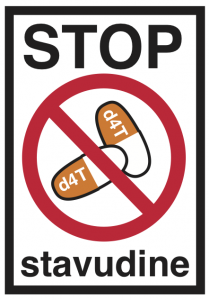Ending global use of d4T: UNITAID to tip market to safer alternatives
25 July 2013. Related: Treatment access, Side effects.
 Simon Collins, HIV i-Base
Simon Collins, HIV i-Base
On 11 June 2013, UNITAID announced in a press statement that it was committing USD $77 million to end of the use of the archaic HIV drug d4T (stavudine) and replace it with tenofovir which is a newer more effective alternative. [1]
Although d4T was widely used in Western countries during the first years of combination therapy, it has been much less used this century, due to the high rates of serious side effects. These include peripheral neuropathy (painful nerve damage that limits mobility), peripheral lipoatrophy (loss of fat cells, notably in the face, arms, legs and buttocks), lactic acidosis (rapid onset, high fatality) and pancreatitis.
About one million people in low-income countries are estimated to still be using d4T due to its lower cost (approximately $79 per year for a d4T-based combination compared to $130 for a tenofovir-based one). [2]
The UNITAID initiative aims to change the current pattern of drug use by reducing the demand for d4T which will in turn increase the price. Conversely, the price for the replacement drug will fall by a further 30%. This project is in strategic collaboration with the Global Fund to Fight HIV/AIDS, Tuberculosis and Malaria. The new tenofovir-based treatment regimen is recommended by WHO.
The press release states “UNITAID’s proposed intervention would address this challenge through negotiating with manufacturers for lower prices and temporarily subsidising the difference between stavudine and tenofovir-based treatment. Various stakeholders would be involved with implementing this proposal, including UNITAID, WHO, the Global Fund, and the Presidents Emergency Plan for AIDS Relief (PEPFAR)”.
UNITAID in an international funding initiative from the governments of Brazil, Chile, France, Norway and the United Kingdom that identifies new sources for funding – 50% of it’s funding comes from a levy on air-tax – to be used in innovative health interventions, working with partners on important issues of public health, including HIV, TB and malaria. [3]
comment
This initiative should be widely publicised. Cost still drives access to health care in most countries, but it is unacceptable that d4T continues to be so widely used just because of a lack of political will to prioritise the quality of treatment.
HIV positive people in resource-limited settings should not have to choose between access to life-saving drugs or the risk of debilitating life-long complications – neuropathy and lipoatrophy are largely irreversible – especially when safer alternatives have been used in Western countries for at least the last decade.
References
- UNITAID press release. UNITAID to provide USD 77 million for better HIV medicines. (11 June 2013).
http://www.unitaid.eu/en/resources/press-centre/releases/1226-unitaid-to-provide-usd-77-million-for-better-hiv-medicines - Clinton Health Access Initiative. ARV Ceiling Price List. May 2013.
http://www.clintonhealthaccess.org/files/CHAI%20ARV%20Ceiling%20Price%202013.pdf (PDF) - UNITAID
http://www.unitaid.org

